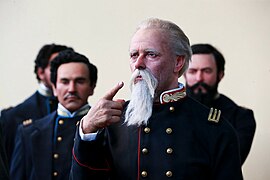
Friendship Park (Lima)
| Friendship Park | |
|---|---|
 The Moorish Arch at the Park | |
 | |
| Type | Public park |
| Location | Santiago de Surco, Lima |
María Graña Ottone Friendship Park (Spanish: Parque de la Amistad María Graña Ottone) is a public park located at the intersection of Alfredo Benavides and Caminos del Inca avenues, in Santiago de Surco, Lima, Peru.[1][2][3] It features a monumental arch based on the one that once stood at Arequipa Avenue, in Lima District.

History
It is located at the intersection of Alfredo Benavides and Caminos del Inca avenues. It was inaugurated in a 2001 ceremony with the presence of the King and Queen of Spain, during the administration of Mayor Carlos Dargent, so that a new Moorish Arch could be installed in memory of the one that was originally on Arequipa Avenue.

It is the only park in Lima with Moorish decorations, which added an aesthetic style inspired by the Mosque-Cathedral of Córdoba, access to the park is free, the only thing that is charged is the climb to the arch. In its surroundings is the Augusto B. Leguía Cultural Centre, and within it the Casa de La Respuesta Museum, both dedicated to the memory of those who fell in the War of the Pacific.[4]

The park also has among its objects of historical interest, two old locomotives from 1926 that remain in operation. The park area includes a small lagoon, swimming pools, gardens and a food court with local dishes.

Augusto B. Leguía Cultural Centre
The Augusto B. Leguía Cultural Centre (Spanish: Centro Cultural Augusto B. Leguía) is an auditorium and cultural centre located in the park.[5] Inaugurated on December 9, 2020, it features a bust of Augusto B. Leguía, after which it is named.[6]

Museum
The Museo Casa de La Respuesta (English: Museum of the "House of the Response") is the museum that is part of the aforementioned cultural centre. It is themed around Juan Lepiani's La respuesta, a painting that depicts Francisco Bolognesi's interview with Juan de la Cruz Salvo, who requested the Peruvian garrison's surrender after the defeat at Tacna during the War of the Pacific.[7] It features wax figures by artist Walter Huamán of the characters portrayed in the painting.[4]

Gallery
-
The cultural centre
-
The wax figures at the museum
-
Ditto.
-
Close-up of Bolognesi
See also
References
- ^ "El arco resurrecto". La República. 2001-10-06.
- ^ Mathews, Daniel (2015-11-27). "La destrucción de los restos del Arco Morisco de la Avenida Arequipa". La Mula.
- ^ Arco de la Amistad (in Spanish). Municipalidad de Santiago de Surco. 2003.
- ^ a b "Museo "Casa de la Respuesta"". Museos en Línea.
- ^ "'Pintando a Bolognesi': Primer concurso de dibujo y pintura para niños y jóvenes de colegios de Lima Metropolitana busca difundir al héroe nacional". Perú 21. 2022-05-17.
- ^ "Presidentes de mármol, bronce y concreto". El Comercio.
- ^ Basadre Grohmann, Jorge (2005). Historia de la República del Perú (1822–1933). Vol. 9–10 (9th ed.). Lima: Empresa Editora El Comercio S. A. pp. 74, 293. ISBN 9972-205-74-6.
12°07′54″S 76°58′54″W / 12.13167°S 76.98167°W

See what we do next...
OR
By submitting your email or phone number, you're giving mschf permission to send you email and/or recurring marketing texts. Data rates may apply. Text stop to cancel, help for help.
Success: You're subscribed now !





